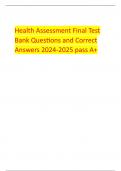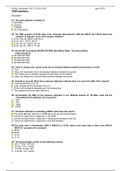Health Assessment Final Test
Bank Questions and Correct
Answers 2024-2025 pass A+
,Rationale: Direct inguinal hernias occur most often in men over the age of 40 years. It is an acquired
weakness brought on by heavy lifting, obesity, chronic cough, or ascites. The direct inguinal hernia is
usually a painless, round swelling close to the pubis in the area of the internal inguinal ring that is easily
reduced when the individual is supine. (See Table 24-6 for a description of scrotal hernia. See Table 24-7
for the descriptions of femoral hernias and indirect inguinal hernias.)
During an examination, the nurse notices that a male patient has a red, round, superficial ulcer with a
yellowish serous discharge on his penis. On palpation, the nurse finds a nontender base that feels like a
small button between the thumb and fingers. At this point the nurse suspects that this patient has:
a. Genital warts.
b. Herpes infection.
c. Syphilitic chancre.
d. Carcinoma lesion. - correct answer-c. Syphilitic chancre.
Rationale: Together with the patients record and laboratory studies, the objective and subjective data
form the data base. The other items are not part of the patients record, laboratory studies, or data.
The nursing process is a sequential method of problem solving that nurses use and includes which steps?
a. Assessment, treatment, planning, evaluation, discharge, and follow-up
b. Admission, assessment, diagnosis, treatment, and discharge planning
c. Admission, diagnosis, treatment, evaluation, and discharge planning
d. Assessment, diagnosis, outcome identification, planning, implementation, and evaluation - correct
answer-d. Assessment, diagnosis, outcome identification, planning, implementation, and evaluation
,Rationale: The nursing process is a method of problem solving that includes assessment, diagnosis,
outcome identification, planning, implementation, and evaluation.
Barriers to incorporating EBP include:
a. Nurses lack of research skills in evaluating the quality of research studies
b. Lack of significant research studies
c. Insufficient clinical skills of nurses
d. Inadequate physical assessment skills - correct answer-a. Nurses lack of research skills in evaluating
the quality of research studies
Rationale: As individuals, nurses lack research skills in evaluating the quality of research studies, are
isolated from other colleagues who are knowledgeable in research, and often lack the time to visit the
library to read research. The other responses are not considered barriers.
The nurse is reviewing data collected after an assessment. Of the data listed below, which would be
considered related cues that would be clustered together during data analysis? Select all that apply.
a. Inspiratory wheezes noted in left lower lobes
b. Hypoactive bowel sounds
c. Nonproductive cough
d. Edema, +2, noted on left hand
e. Patient reports dyspnea upon exertion
, f. Rate of respirations 16 breaths per minute - correct answer-a. Inspiratory wheezes noted in left lower
lobes
c. Nonproductive cough
e. Patient reports dyspnea upon exertion
f. Rate of respirations 16 breaths per minute
Rationale: Clustering related cues help the nurse recognize relationships among the data. The cues
related to the patients respiratory status (e.g., wheezes, cough, report of dyspnea, respiration rate and
rhythm) are all related. Cues related to bowels and peripheral edema are not related to the respiratory
cues.
The nurse is conducting an interview. Which of these statements is true regarding open-ended
questions? Select all that apply.
a. Open-ended questions elicit cold facts
b. They allow for self-expression
c. Open-ended questions build and enhance rapport
d. They leave interactions neutral
e. Open-ended questions call for short one- to two-word answers
f. They are used when narrative information is needed - correct answer-b. They allow for self-expression
c. Open-ended questions build and enhance rapport
f. They are used when narrative information is needed





